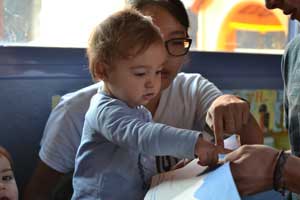
When kids say “the darnedest things,” it’s often in response to something they heard or saw. This sponge-like learning starts at birth, as infants begin to decipher the social world surrounding them long before they can speak.
Now researchers at the University of Washington have found that children as young as 15 months can detect anger when watching other people’s social interactions and then use that emotional information to guide their own behavior.
The study, published in the October/November issue of the journal Cognitive Development, is the first evidence that younger toddlers are capable of using multiple cues from emotions and vision to understand the motivations of the people around them.
“At 15 months of age, children are trying to understand their social world and how people will react,” said lead author Betty Repacholi, a faculty researcher at UW’s Institute for Learning and Brain Sciences and an associate professor of psychology. “In this study we found that toddlers who aren’t yet speaking can use visual and social cues to understand other people – that’s sophisticated cognitive skills for 15-month-olds.”
The findings also linked the toddlers’ impulsive tendencies with their tendency to ignore other people’s anger, suggesting an early indicator for children who may become less willing to abide by rules.
“Self-control ranks as one of the single most important skills that children acquire in the first three years of life,” said co-author Andrew Meltzoff, co-director of the institute. “We measured the origins of self-control and found that most of the toddlers were able to regulate their behavior. But we also discovered huge individual variability, which we think will predict differences in children as they grow up and may even predict important aspects of school readiness.”
In the experiment, 150 toddlers at 15 months of age – an even mix of boys and girls – sat on their parents’ laps and watched as an experimenter sat at a table across from them and demonstrated how to use a few different toys.
Each toy had movable parts that made sounds, such as a strand of plastic beads that made a rattle when dropped into a plastic cup and a small box that “buzzed” when pressed with a wooden stick. The children watched eagerly – leaning forward and sometimes pointing enthusiastically.
Pages: 1 2





